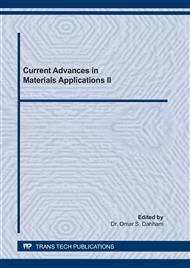[1]
M. Al-Janabi, The Atomic Universe, Iraqi Atomic Energy Publications, Dar al-Arabiya, Baghdad, (1987).
Google Scholar
[2]
IAEA, Radiation, and People, Ch.5 (2004)16-21.
Google Scholar
[3]
M. Abeer Murtada Hameed Al-Saadi, Solid waste and ways to benefit from it in Iraqi industries, Ahl Al-Bait Journal, 1 (2019) 632-647.
Google Scholar
[4]
A. Prüss, E. Giroult P.L. Rushbrook, safe management of Waste from health care activities. Health impacts of health-care waste, World health organization, (1999) 20-30.
Google Scholar
[5]
E.H. Syed, M. Mutahara, and M. Rahman, Medical Waste Management (MWM) in Dhaka, Bangladesh: It's a Review, Home Heal. Care Manag. Pract. 24 (2012) 140–145.
DOI: 10.1177/1084822311425235
Google Scholar
[6]
State of the Environment Outlook Report, Ministry of Environment, Iraq, (2013) 142.
Google Scholar
[7]
K. Kant, S.B. Upadhyay, R.G. Sonkawade, S.K. Chakarvarti, Radiological risk assessment of the use of phosphate fertilizers in soil, Iran. J. Radiat. Res. 4 (2006) 63–70.
Google Scholar
[8]
NEA-OECD, Exposure to radiation from the natural radioactivity in building materials. Report by an NEA group of experts, (1979)78-79.
Google Scholar
[9]
United Nations Scientific Committee on the Effects of Atomic Radiation, Sources and Effects of Atomic Radiation, Report to General Assembly, UNSCEAR, United Nations, (1993).
DOI: 10.18356/0300f937-en
Google Scholar
[10]
IAEA, The Use of Gamma-Ray Data To Define the Natural Radiation Environment, Int. At. Energy Agency (1990) 49.
Google Scholar
[11]
A. Jose, J. Jorge, M. Cleomacio, V. Sueldo, D.S. Romilton, Analysis of the K-40 levels in soil using gamma spectrometry, Brazilian archives of biology and technology 48 (2005) 221-228.
Google Scholar
[12]
H. El-Gamal, A.I.A. El-Mageed, Natural Radioactivity in Water Samples from Assiut City, Int. J. Pure Appl. Sci. Technol, 22 (2014) 44–52.
Google Scholar
[13]
S. Harb, A.H. El-Kamel, A.M. Zahran, A. Abbady, F.A. Ahmed, Assessment of natural radioactivity in soil and water samples from Aden governorate south of Yemen region, International Journal of recent research in Physics and Chemical Sciences, 1 (2014)1-7.
DOI: 10.4103/0972-0464.137476
Google Scholar
[14]
E. Ehsanpour, M.R. Abdi, M. Mostaj, H. Bagheri, 226Ra, 232Th and 40K contents in water samples in part of central deserts in Iran and their potential radiological risk to human population, Journal of Environmental Health Science & Engineering 12 (2014) 1–7.
DOI: 10.1186/2052-336x-12-80
Google Scholar
[15]
A.A. Fakeha, S.Q. Hamidalddin, Z.M. Alamoudy, A.M. Al-Amri, Concentrations of natural radioactivity and their contribution to the absorbed dose from water samples from the Western Province, Saudi Arabia, JKAU Sci. 23 (2011) 17-30.
DOI: 10.4197/sci.23-2.2
Google Scholar
[16]
O.S. Ajayi and G. Adesida, Radioactivity in some sachet drinking water samples produced in Nigeria, Iran. J. Radiat. Res. 7 (2009) 151–158.
Google Scholar
[17]
S. Surinder, R. Asha, K.M. Rakesh, 226Ra, 232Th and 40K analysis in soil samples from some areas of Punjab and Himachal Pradesh, India using gamma-ray spectrum, radiation measurements, 39 (2005) 431-439.
DOI: 10.1016/j.radmeas.2004.09.003
Google Scholar
[18]
UNSCEAR, United nations scientific committee on the effect of atomic radiation, Report to the general assembly. Annex B: Exposures from Natural Radiation Sources, New York, (2000).
DOI: 10.18356/fa7a3c47-en
Google Scholar


